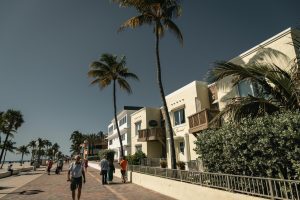Florida is one of the most recognizable travel destinations in the United States. Families from across the country and around the world arrive each year to enjoy its theme parks, beaches, and endless sunshine. Yet while visitors continue to pour in, many locals start moving out of Florida tourist hotspots. This shift, often referred to as reverse travel, is quietly reshaping local communities and raising questions about how Florida will balance its booming tourist economy with the needs of its residents.
How Travel Blogs Add to the Pressure on Locals
The global reach of Florida’s attractions is magnified by the internet with travel blogs that highlight the best beaches, the newest rides, and the most popular restaurants, encouraging millions of readers to add the state to their vacation lists. While this kind of promotion is great for tourism, it often comes at a cost for residents who must share their neighborhoods with growing numbers of visitors. More demand means more traffic, higher rental prices, and a rising cost of living that makes daily life harder for families who call Florida home year-round.
The Double-Edged Sword of Tourism
Tourism provides undeniable benefits for the state. It generates revenue, creates jobs, and keeps businesses thriving. At the same time, those benefits come with challenges that affect residents more than short-term visitors. Streets once lined with local shops are now filled with souvenir stores. Restaurants become harder to access as tourists crowd dining rooms. Beaches that used to provide quiet afternoons turn into busy destinations packed with vacationers. For locals, the constant presence of tourists makes it difficult to maintain a sense of stability and community. What feels exciting to someone staying a week can quickly feel draining when you face it every day.
Cost Pressures and Shrinking Housing Options
Housing prices illustrate this conflict clearly. As demand for vacation rentals grows, investors purchase properties near attractions and turn them into short-term rentals. This drives prices higher and reduces the number of homes available for long-term residents. Families who once could afford to live near the coast or close to a theme park suddenly find themselves priced out of their own neighborhoods. Renters face the same challenge as seasonal visitors, who are willing to pay high rates for short stays. Over time, these pressures force many locals to make tough decisions about where they can realistically live and raise their families.
Families Choosing Stability by Moving Out of State
For some Floridians, the best solution is moving out of state. This decision is not made lightly, as many people have deep roots in Florida. Still, when families weigh the constant stress of crowded roads, limited housing, and high costs against the appeal of other states, the balance often tips toward leaving. States with lower living expenses, stronger job diversity, and fewer tourists become attractive alternatives. Though Florida remains beautiful, the practical challenges push many to seek new beginnings elsewhere.
Staying in Florida but Seeking Quieter Spaces
Not all residents want to give up on Florida completely. Many choose to remain in the state but relocate to smaller towns or suburban communities further from the coast or major tourist centers. These areas may not carry the same name recognition as Miami or Orlando, but they provide better schools, lower housing costs, and calmer streets. Families in these towns can enjoy the benefits of Florida’s warm climate and outdoor lifestyle without constantly fighting against crowds. The choice reflects a desire to balance the love for the state with the need for a better quality of life.


Caption: Families who stay in Florida often choose smaller towns, enjoying calmer streets, better schools, and a more balanced lifestyle.
Four Corners, Florida: A Strategic Choice
One example of this trend is Four Corners Florida, a community just outside Orlando. Its location allows residents to access jobs linked to the tourism industry while avoiding the worst of the congestion. Families living in Four Corners find that they can still benefit from being near major employers, shopping centers, and schools while retreating each evening to quieter neighborhoods. It represents a middle path for those who cannot or do not want to leave Florida entirely but still wish to shield themselves from the constant stress of living in the heart of a tourist destination.
Why Congestion Pushes People Away
Traffic remains one of the strongest motivators when locals start moving out of Florida tourist hotspots. For locals, spending hours in gridlock is not just inconvenient; it is unsustainable. Driving to work, dropping kids off at school, or running errands becomes a time-consuming ordeal when millions of visitors flood the same roads. Parking is another issue, as beach lots and city streets are often filled quickly with out-of-town cars. Public services like buses or medical facilities also face strain when demand exceeds capacity. These everyday challenges make families question whether staying in tourist-heavy areas is worth the frustration, ultimately pushing many to explore other living options.
Turning Relocation into a US Road Trip
For some families, leaving Florida becomes an opportunity rather than just a stressful process. Instead of focusing only on logistics, they turn their move into an adventure by planning a US road trip. They drive across multiple states, visit famous landmarks, and experience places they might never have seen otherwise. This approach transforms relocation into a memorable journey, allowing parents and children to bond while easing the stress of transition. By reforming the move, families can view it as a chance to explore and celebrate, not just as a disruption of their routines.
Economic Shifts in Local Communities
The departure of locals has ripple effects on both tourist regions and the towns they move into. Areas losing residents may struggle to maintain local schools, small businesses, and community organizations. When neighborhoods become dominated by short-term rentals, the sense of stability weakens, and support for local infrastructure declines. On the other hand, quieter towns often benefit from incoming residents who bring new demand for housing, services, and businesses. These shifts create opportunities for growth in unexpected areas, showing how the choices of individuals can collectively reshape Florida’s broader economic and social landscape.
The Role of Remote Work and Flexibility
Remote work has expanded the possibilities for relocation. Families no longer need to live near major employers if their jobs can be done online. This change has freed many from relying on opportunities tied to tourist-heavy areas. A parent can work for a company in another state while living in a smaller Florida town. Students can take online classes without commuting to busy cities. This flexibility helps locals move into communities that better fit their priorities while maintaining income and education opportunities. It is a powerful tool that has accelerated the trend of reverse travel in Florida.


Caption: Remote work lets Florida families leave crowded tourist hubs while keeping jobs and studies, opening doors to calmer communities.
Looking Ahead Beyond Florida Tourist Hotspots
When locals start moving out of Florida tourist hotspots, this highlights a decisive shift. While tourism remains a cornerstone of Florida’s economy, the long-term success of the state also depends on protecting livability for residents. To maintain its appeal for both visitors and those who call it home, Florida must prioritize affordable housing, safer neighborhoods, and uninterrupted access to essential services. Only by balancing tourism with the needs of residents can the state thrive for generations to come.


